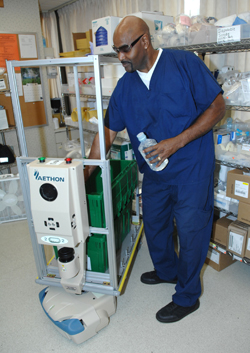
Thaddeaus Ware loads supplies on one of the new robots for delivery on the hospital’s ninth floor. (photo by Neil Brake)
Robots Tilly and Mo set supply chain in motion
The Jetsons had Rosie, Luke Skywalker had R2-D2 and C-3PO and now Vanderbilt Medical Center has Tilly and Mo.
The newest employees of Supply Chain, robots Tilly and Mo have been making supply deliveries throughout Vanderbilt University Hospital since Monday.
“Tilly and Mo have been working hard for their first week. They have provided conveniences to so many areas, and the Supply Chain is excited to have them on board,” said Lori Langmade, manager of Central Receiving.
The robots are called “Tugs,” by Aethon, the company that created and manages them, because of their tugboat-like capabilities, but Supply Chain held a contest to give the robots more personal names.
Robert Harmon, a clinical supply specialist, submitted the winning entries. “'Tilly' because a garden tiller works very hard to prepare soil for planting, and 'Mo' because they are motorized and in motion as they move supplies from one place to another,” Harmon said.
The robots eliminate the need to walk to Central Receiving to retrieve boxes, allowing staff to focus on patient care rather than running errands. The robots are efficient and reliable, said Becky Wells, Supply Chain Program Manager.
The robots only need to rest at their docking station for five minutes every hour to recharge their batteries, and this can be done while the next shipment is being loaded.
Each robot has an onboard computer and is tracked via wireless routers. A touch-screen in central receiving allows staff to program a delivery location for each robot and to track the robots when they are away making deliveries.
The robots are also monitored by Aethon staff in Pittsburgh around the clock. If the robot encounters a problem, it calls the Aethon service desk. The technician there can access the onboard camera, assess the situation and remotely control the robot. Staff can also call the service desk at (888) 201-9522 if they notice a robot is lost or disabled.
Detailed maps of VMC and The Vanderbilt Clinic have been programmed into each robot so they can navigate the buildings.
When a robot is on the move, it constantly scans for obstacles. If it must go around an object or across a hallway, it announces its intentions before moving. Robots also have the ability to ride service elevator 10 by remotely summoning the car and selecting the desired floor.
Each robot has a large red button that acts as a “pause” button so it can be disabled. If, for example, the robot is in the way, staff should press the red button, move the robot, and then press the green button to re-engage the robot.
When the robot reaches its destination, it announces to staff that a delivery has arrived. They then remove their supplies and press the green button, and the robot takes off for its next delivery.
Because the robots rely on precise distance measurements to find their way around, care should be taken not to bump them off course. They also need to ride the elevator alone so they have room to maneuver. People can assist the robots and increase efficiency by moving obstacles from their path.
Medical Center staff has received instructions on how to operate the robots. There are also posters and table tents offering do's and don'ts, which will help educate visitors. With all the advertising, Langmade doesn't anticipate problems.
“It will be foreign at first, but I think they'll warm up when they use them, especially once they see what a convenience they are,” she said.
Debbie Patterson, R.N., said it was weird to be working with robots, but Thaddeaus Ware, a clinical supply specialist, recognized the additional benefits the robots could have outside the hospital.
“I wish I could have one at home, that would free up my time considerably,” he said.













